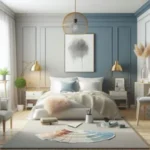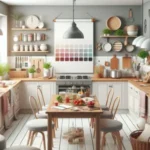Your front door is more than just an entrance; it’s the focal point of your home and the first impression visitors receive.
Choosing the right paint color for your front door can significantly enhance your home’s curb appeal, setting the tone for the entire exterior and reflecting your personal style. With a myriad of colors and finishes available, selecting the perfect hue can be both exciting and overwhelming. From vibrant reds that exude warmth and welcome to serene blues that evoke tranquility, each color carries its unique charm and message. In this guide, we will explore the art of selecting the ideal paint color for your front door, considering factors such as architectural style, neighborhood aesthetics, and your own personality. Get ready to transform your entryway into a stunning statement that captivates and invites, because unlocking curb appeal starts right at your front door!
1. Understanding Curb Appeal: Why Your Front Door Matters
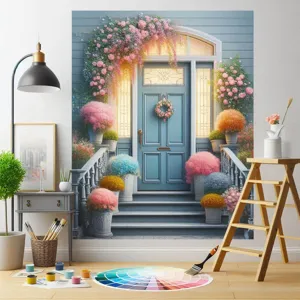
When it comes to enhancing the overall aesthetic of your home, the front door is often an overlooked hero. Curb appeal is the first impression your home makes on visitors and passersby, and your front door plays a pivotal role in shaping that impression. It’s not just an entry point; it’s a statement piece that can reflect your personal style, set the tone for your home’s design, and invite warmth and welcome.
Think about it: Your front door is the focal point of your exterior. It’s the gateway to your sanctuary, and its color can evoke emotions, convey character, and even boost your home’s value. A well-chosen paint color can transform a mundane entryway into a lively, inviting space that draws in the eye and sparks curiosity. Whether you’re aiming for a classic, sophisticated look with deep navy or a cheerful pop with vibrant yellow, the color you choose can tell a story about your home.
Additionally, a thoughtfully painted front door can help unify your home’s exterior. If your home has a traditional brick facade, a rich forest green or burgundy can complement the earthy tones beautifully. Conversely, a sleek modern home may benefit from a bold and unexpected hue, such as a striking coral or a sleek black, to create a contrast that speaks to contemporary design.
Understanding curb appeal means recognizing that every detail counts. A freshly painted front door not only enhances the visual appeal of your home but also communicates care and attention to detail. In neighborhoods where homes are closely situated, a vibrant front door can make yours stand out, inviting compliments from neighbors and increasing the likelihood of potential buyers taking notice should you ever decide to sell.
In essence, your front door is more than just an entrance; it’s a canvas for expression and a critical component of your home’s first impression. By investing time and thought into choosing the perfect paint color, you can unlock the full potential of your curb appeal, transforming ordinary entrances into extraordinary welcomes.
2. Factors to Consider When Choosing a Paint Color
Choosing the perfect paint color for your front door is more than just a matter of personal preference; it’s about understanding the various factors that can significantly influence your selection. Here are some critical elements to consider as you embark on this colorful journey:
**1. Architectural Style:** The design of your home plays a significant role in determining which colors work best. A modern home with clean lines may benefit from bold, contemporary colors like deep navy or vibrant red, while a quaint cottage might look more charming with softer hues such as pastel blue or sage green. Take a moment to examine your property’s architectural details; they can guide you toward a color palette that enhances the overall aesthetic.
**2. Neighborhood Trends:** Consider the colors of neighboring houses. While you want your home to stand out, you also want it to harmonize with its surroundings. Take a leisurely stroll through your neighborhood or drive around to capture the color schemes of nearby homes. This can provide inspiration and help you avoid a decision that may clash with the overall vibe of your community.
**3. Existing Elements:** Take stock of existing features such as siding, roofing, and landscaping. The front door color should complement these elements rather than compete with them. For instance, if your home has warm beige siding, a cool-toned door might look out of place. Aim for a cohesive look by selecting a color that enhances or contrasts beautifully with your home’s exterior.
**4. Psychological Impact:** Colors evoke emotions and can influence perceptions. A cheerful yellow can project warmth and friendliness, while a deep green may evoke a sense of tranquility and nature. Think about the message you want to convey to visitors and passersby. For a bold statement that exudes confidence, opt for a striking red or a sophisticated black.
**5. Climate Considerations:** Local climate can also affect your choice. In sunny areas, lighter colors may fade quickly, while darker colors can absorb heat and become overly hot. Conversely, in cooler climates, a warm color can create a welcoming feel. Consider how the weather will influence the longevity of your paint job and how often you might need to refresh it.
**6. Personal Style:** Finally, never underestimate the power of personal preference. Your front door is a canvas – a reflection of your personality and style. Whether you lean towards vibrant and adventurous or prefer a classic and understated look, your choice should ultimately resonate with who you are.
By weighing these factors carefully, you’ll find that the perfect paint color for your front door is not just a choice; it’s an opportunity to enhance your home’s curb appeal and express your unique style. Take your time, test samples, and envision how each color will complement your home’s overall look before making a final decision.
3. Analyzing Your Home’s Style and Architecture
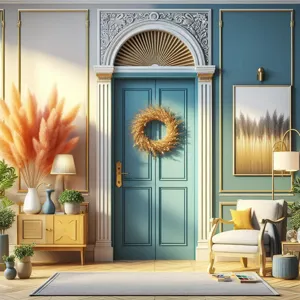
When it comes to choosing the perfect paint color for your front door, understanding your home’s style and architecture is crucial. Your front door serves as a focal point and sets the tone for your entire property; therefore, it should harmonize with the overall aesthetic of your home.
Begin by taking a step back and analyzing the architectural features of your house. Is it a charming cottage with rustic details, a sleek modern design with clean lines, or perhaps a classic Victorian with intricate embellishments? Each style has its own character, and the right color can accentuate these features beautifully. For instance, a bold red or navy blue can add a touch of drama to a contemporary home, while softer, muted tones like sage green or buttery yellow might be more appropriate for a quaint farmhouse.
Consider also the materials used in your home’s facade. If you have natural stone or brick, selecting a door color that complements these elements can create a cohesive look. Earthy tones can enhance the organic appeal, while a contrasting color can offer a striking visual impact. Additionally, take note of any existing trim or window frames; your door color should work in tandem with these accents to create a unified appearance.
Don’t forget about the surrounding landscape as well. The colors of your plants, flowers, and any outdoor furniture can influence how your door color is perceived. A vibrant turquoise door might pop against a backdrop of lush greenery, while a deep burgundy could provide a stunning contrast to white or pastel blooms.
Ultimately, the key is to choose a paint color that not only aligns with your home’s architectural style but also reflects your personal taste. Remember, your front door is an invitation to your home—make sure it welcomes guests with warmth and charm while enhancing the overall curb appeal of your property.
4. The Psychology of Color: What Different Colors Convey
Choosing the right color for your front door is not just about aesthetics; it’s also about the profound psychological effects that colors can have on our emotions and perceptions. Understanding the psychology of color can guide you in selecting a hue that not only enhances your home’s curb appeal but also communicates the right message to visitors and passersby.
**Red** is a bold choice that exudes energy and passion. It’s often associated with warmth and excitement, making it an ideal color for those who want to draw attention and create a welcoming atmosphere. A red front door can signify a sense of adventure and boldness, inviting guests to step inside and experience the vibrancy of your home.
**Blue**, on the other hand, conveys tranquility and trust. A light blue or soft seafoam can evoke feelings of calmness and serenity, while a deeper navy can suggest stability and reliability. Painting your front door blue can create a sense of peace, making your home feel like a sanctuary amidst the chaos of the outside world.
**Yellow** is the color of sunshine and happiness. A cheerful yellow door can brighten up your home’s exterior and evoke feelings of warmth and friendliness. It’s an inviting color that can make your home feel approachable, perfect for those who want to create a welcoming vibe.
**Green** symbolizes nature, renewal, and growth. A green door can bring a sense of harmony and balance to your home’s facade. Depending on the shade, it can convey a connection to the environment, making it a great choice for eco-conscious homeowners or those living in leafy neighborhoods.
**Black** embodies sophistication and elegance. A sleek black door can make a powerful statement, suggesting strength and formality. It’s a versatile choice that pairs beautifully with a range of exterior styles, from traditional to modern, and can add a touch of luxury to your home’s entrance.
**White** is the epitome of simplicity and purity. A white front door can symbolize cleanliness and openness, projecting a sense of peace and tranquility. It works well in various architectural styles and can create a fresh, airy feel, making it an excellent choice for coastal or minimalist homes.
As you consider these colors, think about the message you want to convey and how you want to make people feel as they approach your home. The right front door color can not only elevate your home’s curb appeal but also set the tone for what lies beyond. Embrace the psychology of color and choose a hue that reflects your personality while enhancing your home’s overall aesthetic.
5. Popular Front Door Colors and Their Meanings
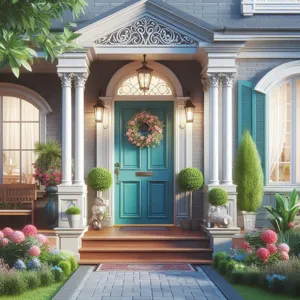
Choosing the right color for your front door is more than just a matter of aesthetics; it’s a reflection of your personality and an expression of your home’s character. different colors evoke various feelings and associations, and understanding these can help you unlock the full potential of your curb appeal. Here’s a look at some of the most popular front door colors and their meanings:
**1. Classic Red:** A timeless choice, red is often associated with warmth, comfort, and love. It exudes confidence and draws the eye, making it an ideal color for those who want to make a bold statement. Historically, a red door symbolizes a welcoming home, so it’s perfect for creating an inviting atmosphere.
**2. Tranquil Blue:** Shades of blue, particularly softer tones like sky blue or powder blue, evoke feelings of tranquility and serenity. This color is associated with trust and stability, making it an excellent choice for coastal or suburban homes. A blue door can serve as a soothing contrast against natural greenery.
**3. Elegant Black:** A black front door signifies sophistication and elegance. It’s a choice that conveys strength and authority, often found in modern or traditional homes alike. Black doors work well with a variety of architectural styles and can add a touch of drama and refinement to your entryway.
**4. Cheerful Yellow:** Bright and inviting, yellow is a color that embodies positivity and happiness. A cheerful yellow door can instantly uplift the mood of your home, making it a perfect choice for those who want to convey a sense of friendliness and approachability. It’s a popular option for beach houses or homes in sunny climates.
**5. Earthy Green:** Green is synonymous with nature and renewal. A muted sage or deep forest green can create a calming effect, while also blending seamlessly with outdoor landscaping. This color choice can suggest a love for the environment and a desire for harmony, making it an excellent option for eco-conscious homeowners.
**6. Crisp White:** A classic white door offers a clean, fresh look that never goes out of style. It symbolizes purity and simplicity, and works beautifully with any exterior color. A white door can enhance the architectural features of your home while providing a timeless appeal.
By understanding the meanings behind these popular front door colors, you can make a more informed decision that not only enhances your home’s curb appeal but also communicates the essence of who you are. Whether you opt for a bold statement or a subtle elegance, your front door color is a key element in creating a welcoming first impression.
6. Coordinating with Your Home’s Exterior Color Palette
When it comes to selecting the perfect paint color for your front door, one of the most crucial steps is to ensure it harmonizes beautifully with your home’s exterior color palette. Your front door is not just a functional element; it’s the focal point that invites guests into your home and sets the tone for your entire property. Therefore, choosing a color that complements the surrounding hues can make a significant difference in achieving that coveted curb appeal.
Begin by taking a close look at your home’s existing color scheme. Consider the primary color of your exterior walls, the roofing materials, and any trim or accents that define the structure’s character. For instance, a soft, muted beige or gray home might benefit from a bold front door color, such as deep navy or vibrant red, to create an eye-catching contrast. Conversely, if your home features a bright, cheerful facade, a more subdued or monochromatic door color, like a gentle sage or classic white, can provide a sophisticated balance.
Additionally, think about the architectural style of your home. A traditional colonial house might call for a classic black or glossy red door, while a modern minimalist home could shine with a sleek, muted color like charcoal or even a striking matte finish. Don’t forget to consider the seasonal changes in your environment as well—colors that look stunning in bright summer sunlight might appear completely different under the muted tones of winter.
To help visualize your options, create a mood board or use digital tools that allow you to experiment with different color combinations. Take photos of your home and overlay potential door colors to see how they interact with your existing palette. This strategic approach not only ensures that your front door looks inviting but also elevates your home’s overall aesthetic, making it stand out beautifully in the neighborhood. Remember, the goal is to choose a color that feels cohesive and enhances the charm of your home, ultimately creating a welcoming entry that draws people in.
7. Seasonal Considerations for Front Door Colors
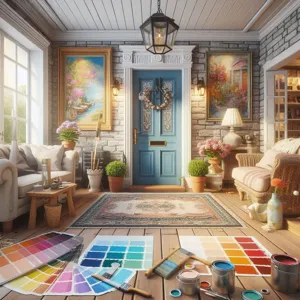
When it comes to choosing the perfect paint color for your front door, seasonal considerations play a crucial role in enhancing your home’s curb appeal throughout the year. Each season brings with it a unique palette of colors inspired by nature, and aligning your door’s hue with these seasonal changes can create a harmonious and inviting appearance.
In spring, when the world bursts into bloom, consider opting for pastel shades like soft pink, mint green, or buttery yellow. These colors evoke a sense of renewal and warmth, welcoming guests with the promise of new beginnings. Imagine stepping into a home with a pale lavender door framed by blossoming flowers; it sets a cheerful tone that mirrors the vibrancy of the season.
As summer arrives, bold colors can take center stage. Think bright reds, sunny yellows, or deep ocean blues that capture the essence of long, sun-drenched days. A striking navy door paired with white or bright yellow accents can create a stunning contrast, making your home stand out in the lush greenery of summer.
When autumn rolls around, rich, earthy tones become the stars of the show. Shades like burnt orange, deep burgundy, and golden mustard can complement the falling leaves and create a cozy, inviting atmosphere. A warm, chestnut-colored door can evoke images of crisp air and gatherings around a fire pit, inviting guests to come in and enjoy the warmth of your home.
In winter, cooler colors take precedence. Consider classic shades such as deep forest green or a crisp, timeless black—colors that offer a sophisticated, elegant look against a backdrop of snow or frost. A black door adorned with a festive wreath can provide a stunning focal point that captures the essence of the holiday season.
Incorporating seasonal considerations into your front door color choice not only enhances your home’s curb appeal but also reflects your personal style throughout the year. By thoughtfully selecting colors that resonate with the season, you can create a welcoming entrance that invites guests to experience the warmth and charm of your home, no matter the time of year.
8. Testing Paint Colors: Swatches and Samples
When it comes to selecting the perfect paint color for your front door, the art of testing paint colors is an essential step that can make all the difference in achieving the aesthetic you desire. Swatches and samples are your best friends in this creative journey, allowing you to visualize how different hues will interact with your home’s exterior and the surrounding landscape.
Start by gathering a variety of paint swatches that catch your eye. Many paint stores offer fan decks or sample pots, providing a range of shades from which to choose. Once you have a selection, take the time to hold them up against your door frame or even tape them directly to the door. This initial visual comparison can help you narrow down your options before committing to larger quantities.
However, the real magic happens when you move to the next step: applying actual paint samples. Choose a few of your favorite colors and paint small sections on your door. This will allow you to see how the colors look in different lighting conditions throughout the day, as natural light can dramatically alter the perception of a color. Morning sunlight, afternoon brightness, and evening shadows can all bring out different tones in the paint, revealing undertones that may not have been visible in the store.
Additionally, consider the surroundings of your home. The color of your siding, the style of your home, and even the landscape can influence how a color appears. A vibrant red door may pop beautifully against a neutral façade but could clash with an earthy stone exterior. By testing samples on your door and observing them at various times of the day, you’ll gain valuable insight into how well the colors harmonize with your home’s overall aesthetic.
In the end, this method of testing paint colors not only builds your confidence in your choice but also ensures that your front door becomes a stunning focal point that enhances your home’s curb appeal. So take your time, experiment, and enjoy the creative process of finding that perfect shade that welcomes guests with warmth and style.
9. The Role of Finish: Matte vs. Glossy Paint
When it comes to selecting the perfect paint color for your front door, the finish you choose can be just as important as the hue itself. The debate between matte and glossy finishes may seem minor, but it plays a significant role in both aesthetic appeal and functionality.
**Matte Finish:** A matte finish offers a soft, understated look that exudes elegance and sophistication. It can create a welcoming atmosphere, especially in warmer, earthy tones like terracotta or sage green. However, while matte paint can beautifully conceal imperfections in the door’s surface, it can be less durable when it comes to withstanding the elements. Matte finishes are more prone to showing dirt and scuff marks, which means your door may require more frequent touch-ups to maintain its fresh appearance. If you opt for a matte finish, consider using it in sheltered areas or where the door won’t be exposed to heavy wear and tear.
**Glossy Finish:** On the other hand, a glossy finish radiates vibrancy and energy, making colors appear more vivid. Glossy doors often catch the eye and can create a modern, chic look, particularly in bold shades such as navy blue or bright red. Beyond aesthetics, glossy finishes are also highly durable and resistant to moisture, making them ideal for exterior doors that face harsh weather conditions. They’re easier to clean, as dirt and grime can be wiped off with a damp cloth. However, the reflective nature of glossy finishes can sometimes amplify imperfections, so it’s essential to ensure the door’s surface is in good condition before application.
Ultimately, the choice between matte and glossy finishes should align with your home’s overall style, your maintenance preferences, and the message you want your front door to convey. Whether you lean towards the subtle charm of a matte finish or the striking allure of a glossy coat, both options can significantly enhance your front door’s curb appeal and make a lasting impression on visitors.
10. Enhancing Front Door Accents: Hardware and Accessories
When it comes to making a striking impression, the right paint color for your front door is just the beginning. To truly elevate the curb appeal of your home, you must consider the accessories and hardware that complement your chosen hue. Think of these elements as the jewelry to your door’s outfit—small details that can make all the difference in creating a cohesive and inviting entrance.
Start with the door hardware: doorknobs, hinges, and knockers. Opt for finishes that resonate with your door color while also enhancing its overall aesthetic. For example, a crisp white door pops beautifully against shiny brass or polished chrome hardware, while deeper shades like navy blue or forest green create a stunning contrast with matte black or antique bronze accents. Mixing metals can also add a modern twist, but be mindful to maintain a sense of balance; too many conflicting finishes can detract from your door’s beauty.
Next, consider the addition of accessories such as door mats, wreaths, and decorative house numbers. A vibrant welcome mat can introduce a playful element that draws the eye while also providing functionality. Seasonal wreaths, whether made from fresh blooms or durable faux materials, offer a personal touch and can be easily swapped out to reflect the changing seasons or your mood.
Don’t forget about lighting! Wall sconces or pendant lights flanking your door not only provide practical illumination but also frame the entrance, adding depth and warmth to your home’s exterior. Choose fixtures that coordinate with your door’s style—sleek and modern for contemporary homes, or ornate and vintage for more traditional aesthetics.
By thoughtfully enhancing your front door with complementary hardware and accessories, you create a welcoming atmosphere that invites guests in and leaves a lasting impression. Remember, the front door is the focal point of your home’s facade; treat it as the canvas that deserves attention to detail and a touch of personality.
11. Maintenance Tips for Keeping Your Front Door Color Fresh
Once you’ve chosen the perfect paint color for your front door, the next step is ensuring it remains vibrant and inviting for years to come. Regular maintenance is essential for preserving the aesthetic appeal of your door and protecting it from the elements. Here are some practical tips to keep your front door looking fresh and welcoming:
**1. Regular Cleaning:** Dust, dirt, and grime can accumulate on your front door, dulling its vibrancy. Make it a habit to wipe down your door every few weeks with a soft cloth and a gentle soap solution. For painted surfaces, avoid harsh chemicals that can strip the paint; instead, opt for mild detergents that won’t compromise the finish.
**2. Inspect for Damage:** Periodically check your door for any signs of wear and tear, such as peeling paint, scratches, or dents. Early detection allows you to address these issues before they escalate. If you notice any problems, consider touching up the paint or making minor repairs to maintain the door’s integrity.
**3. Repaint When Necessary:** Depending on your local climate and the quality of the paint used, you may need to repaint your door every few years. Signs that it’s time for a refresh include noticeable fading, chipping, or if the door begins to look dull. Repainting not only revives the color but also fortifies the surface against weather-related damage.
**4. Protect from the Elements:** If your front door is exposed to harsh sunlight or extreme weather conditions, consider using a sealant or protective coat. These products can help shield the paint from UV rays, moisture, and other environmental factors that can cause fading or deterioration.
**5. Seasonal Touch-Ups:** Changes in seasons can impact the appearance of your door. Take advantage of the spring and fall to give it a little extra love with a thorough cleaning and inspection. This seasonal maintenance not only keeps your door looking its best but also prepares it for the harsher weather ahead.
By following these maintenance tips, you can ensure that your front door remains a stunning focal point that enhances your home’s curb appeal. A well-maintained door not only invites guests in but also reflects the care and attention you put into your home’s overall appearance.
12. DIY vs. Professional Painting: What You Need to Know
When it comes to painting your front door, you may find yourself at a crossroads: should you tackle the project as a DIY endeavor, or is it best to enlist the expertise of a professional? Both options come with their own set of advantages and considerations that can significantly impact the outcome of your curb appeal transformation.
**DIY Painting: The Joy of Personal Touch**
Opting for a DIY approach can be incredibly rewarding. It allows you to infuse your personal style into the project, and there’s a certain satisfaction that comes from completing a task with your own hands. Before diving in, however, it’s essential to do your homework. Research the best types of paint for exterior surfaces, and make sure to choose a high-quality primer that will ensure the longevity of your work. Additionally, invest in proper tools—brushes, rollers, and painter’s tape—to achieve a clean and professional finish.
The DIY route also provides flexibility. You can work on your own schedule, take breaks when needed, and experiment with different colors and techniques without the pressure of a deadline. However, be prepared for the possibility of additional time commitment, especially if you’re new to painting.
**Professional Painting: Expertise at Your Service**
On the other hand, hiring a professional painter brings a different set of benefits to the table. With their experience, they can navigate color choices and application techniques that you may not consider, ensuring a flawless finish. Professionals also come equipped with high-quality tools and materials, and they are skilled at preparing surfaces to prevent issues like peeling or chipping down the line.
While the cost of hiring a pro may be higher upfront, the investment can pay off in durability and aesthetic appeal. Moreover, a professional can often complete the job in less time, allowing you to enjoy your newly painted front door sooner rather than later.
**Making the Choice**
Ultimately, the decision between DIY and professional painting hinges on your budget, time, and comfort level with home improvement tasks. If you’re confident in your abilities and eager for a hands-on project, a DIY approach could be perfect for you. However, if you prefer a polished look without the stress, hiring a professional might be the way to go. Whichever path you choose, the end goal remains the same: a beautiful front door that enhances your home’s curb appeal and welcomes guests with warmth and style.
13. Eco-Friendly Paint Options for the Environmentally Conscious
As the movement towards sustainability continues to grow, many homeowners are seeking eco-friendly options that align with their values while enhancing their home’s curb appeal. When selecting a paint color for your front door, consider opting for environmentally conscious paint products that minimize harmful chemicals and promote better air quality both inside and outside your home.
Eco-friendly paints, often labeled as low-VOC (volatile organic compounds) or zero-VOC, reduce the release of toxic fumes and are safer for your family and pets. These paints offer a range of beautiful colors, allowing you to choose shades that reflect your personal style while being gentle on the planet. Popular eco-friendly brands are now creating vibrant color palettes, from deep navy blues to sunny yellows, ensuring that you don’t have to compromise on aesthetics for sustainability.
Beyond the color itself, look for paints that are made from natural materials, such as plant-based oils and minerals, which not only reduce environmental impact but also provide a unique depth to the finish. These paints are often more durable as well, requiring fewer coats and less maintenance over time—perfect for homeowners who want to make a stylish statement without frequent touch-ups.
Additionally, consider the environmental impact of your choice by checking for certifications like Green Seal or the Environmental Protection Agency’s Safer Choice label. These certifications indicate that the product meets strict environmental standards, ensuring that your choice contributes to a healthier planet.
By choosing eco-friendly paint options for your front door, you can unlock a new level of curb appeal while making a positive impact on the environment. Not only will your door stand out with its fresh, vibrant color, but it will also reflect your commitment to sustainable living, inviting friends and neighbors to admire both your home and your values.
14. Real-Life Examples: Inspiring Front Door Transformations
When it comes to front door transformations, real-life examples can provide not only inspiration but also practical insights into what works and what doesn’t. Take, for instance, the charming yellow door of a quaint cottage in a suburban neighborhood. This vibrant hue instantly brightens the facade, creating a welcoming atmosphere that beckons guests and passersby alike. The homeowners chose a soft butter yellow, which harmonizes beautifully with their muted gray siding and white trim. The result? A cheerful entryway that radiates warmth and positivity.
Another striking example can be found in a more modern setting, where a sleek navy blue door serves as a stunning contrast against warm beige brick. The deep, rich color adds a touch of sophistication and elegance while seamlessly fitting into the contemporary aesthetic of the home. Accented by polished brass hardware, this door not only draws the eye but also elevates the overall curb appeal of the property.
For those leaning towards a more rustic vibe, consider the transformation of a traditional farmhouse with a bold red door. This choice pays homage to classic design while adding a pop of color that stands out against the natural wood and earthy tones of the home. The red door, adorned with a simple wreath, invites visitors with a sense of nostalgia and charm.
These examples illustrate that choosing the right paint color for your front door is more than just a cosmetic update; it’s an opportunity to express your personal style and enhance the overall aesthetic of your home. Whether you opt for a bold statement color or a more subdued tone, the key is to ensure that it complements the surrounding elements and reflects the character of your home. With a little creativity and inspiration from these transformations, you can unlock the full potential of your front door and boost your home’s curb appeal.
15. Final Thoughts: Choosing a Color That Reflects Your Personality
Choosing the perfect paint color for your front door is not just a matter of aesthetics; it’s a reflection of who you are and the welcoming atmosphere you wish to create. As you stand before the daunting array of colors, think about what each hue conveys. A vibrant red door speaks volumes of energy and passion, while a serene blue invokes calmness and tranquility.
Consider the overall style of your home and the surrounding landscape. Is it a modern minimalist abode or a charming cottage? The door color should harmonize with the architecture, enhancing its character rather than clashing with it. Don’t hesitate to draw inspiration from your favorite colors, artwork, or even the seasons. A sunny yellow might evoke feelings of warmth and cheer, while an earthy green can express a connection to nature.
Moreover, your door serves as the first impression for visitors and passersby, so think about the emotions you want to evoke. A classic black door symbolizes elegance and sophistication, while a playful orange invites a sense of fun and creativity.
Ultimately, the best color is one that resonates with you personally. It should make your heart smile every time you come home. Take your time, gather samples, and visualize how different shades will appear at various times of the day. Remember, this is not merely a paint choice; it’s an opportunity to express your individuality and create a welcoming entryway that invites warmth and connection into your home. So go ahead, embrace your creativity, and let your front door become a reflection of your unique personality.
In conclusion, choosing the perfect paint color for your front door is a powerful way to enhance your home’s curb appeal and create a welcoming atmosphere. By considering factors such as your home’s architectural style, the surrounding landscape, and your personal taste, you can select a color that not only stands out but also complements your overall aesthetic. Whether you opt for a bold hue that makes a statement or a soft shade that exudes charm, remember that your front door is the first impression visitors will have of your home. We hope this guide has inspired you to embark on your painting project with confidence and creativity. Transform your entryway into a reflection of your style, and watch as your home radiates warmth and character. Happy painting!



